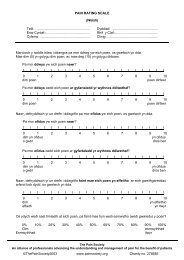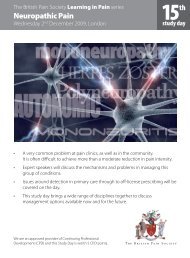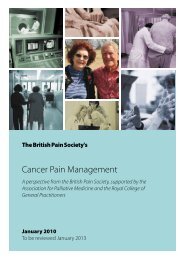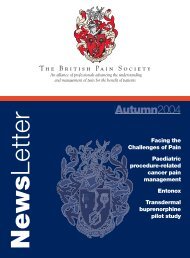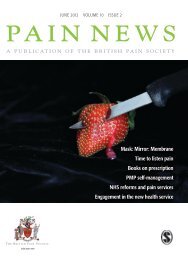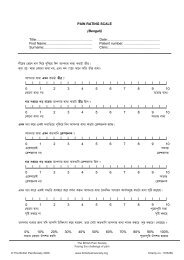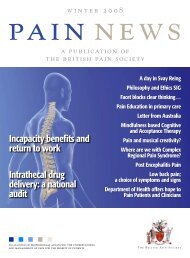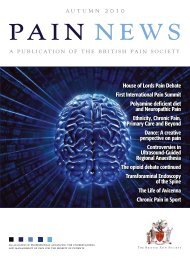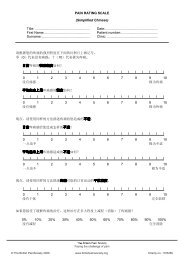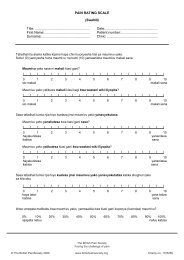Summer 2010 - The British Pain Society
Summer 2010 - The British Pain Society
Summer 2010 - The British Pain Society
Create successful ePaper yourself
Turn your PDF publications into a flip-book with our unique Google optimized e-Paper software.
3 studies ( n=25,34,56) looked at<br />
the use of intravenous ketamine<br />
infusion to predict the response to<br />
the oral NMDA receptor antagonist<br />
dextromethorphan. One study<br />
(n=8) evaluated the efficacy of oral<br />
ketamine in subjects who responded<br />
positively to an infusion of ketamine.<br />
<strong>The</strong> authors emphasise the flaws<br />
associated with these studies namely<br />
short follow up period, use of single<br />
dose ketamine (0.1mg/kg) and the<br />
absence of any control treatment<br />
group. <strong>The</strong> review concludes that<br />
the studies included provide weak<br />
evidence supporting the use of a<br />
ketamine infusion test to predict<br />
short term treatment response to<br />
oral NMDA receptor antagonist<br />
therapy for both neuropathic and<br />
nociceptive pain.<br />
<strong>The</strong>re were 4 studies (n=48,12,16,26)<br />
that looked at the use of opioid<br />
infusions to predict response to<br />
either oral or transdermal opioid.<br />
<strong>The</strong>se yielded mixed results. 2<br />
studies showed very poor correlation<br />
between the predictive results of an<br />
opioid infusion test and response<br />
to oral opioids while two studies<br />
showed that there was a correlation<br />
between the responses but only<br />
a small percentage of patients<br />
reported sustained benefit from oral<br />
opioids lasting at least 6 months.<br />
<strong>The</strong>re were 3 studies (n=104,6,41)<br />
and one case report looking at the<br />
predictive effects of IV phentolamine.<br />
<strong>The</strong>re are a number of significant<br />
flaws with these studies. <strong>The</strong><br />
authors of the systematic review<br />
concluded that there was no<br />
credible evidence that the use<br />
of intravenous phentolamine<br />
infusion reliably predicts response<br />
to pharmacological sympathetic<br />
blockade (transdermal or oral<br />
clonidine used in these studies), and<br />
only weak evidence supporting the<br />
use of intravenous phentolamine<br />
before intravenous regional<br />
guanethidine.<br />
Despite having very liberal inclusion<br />
criteria in this review, there is little<br />
data on the predictive value of<br />
intravenous analgesic infusion tests.<br />
It is surprising that there is a paucity<br />
of literature available to support<br />
a commonly used test in pain<br />
management. Further, randomised,<br />
double blind studies are obviously<br />
required to determine the predictive<br />
nature of these tests.<br />
PAIN SHORTCUTS<br />
Group cognitive behavioural<br />
treatment for low back pain<br />
in primary care<br />
cognitive behavioural intervention.<br />
Subjects in the Control, advice only,<br />
group received a copy of the ‘back<br />
book’ and a 15 minute session on<br />
active management advice delivered<br />
by a nurse or physiotherapist. <strong>The</strong><br />
intervention group subjects attended<br />
the Back skills training programme,<br />
which comprises an individual<br />
assessment and 6 sessions of group<br />
cognitive behavioural therapy.<br />
This cognitive behavioural therapy<br />
targets behaviours and beliefs about<br />
physical activity and avoidance of<br />
activity. Subjects were deemed to<br />
be compliant with the cognitive<br />
behavioural intervention if they<br />
attended the initial assessment and<br />
at least 3 of the subsequent sessions.<br />
Outcomes were assessed at 3, 6 and<br />
12 months after randomisation by<br />
postal questionnaire. Subjects were<br />
asked to fill in the Roland Morris<br />
disability questionnaire and the<br />
modified Von Korff scale, mental<br />
and physical health related quality<br />
of life survey, fear avoidance beliefs<br />
questionnaire, pain self-efficacy scale<br />
and a questionnaire relating to selfrated<br />
benefit from and satisfaction<br />
with treatment. <strong>The</strong> authors<br />
estimated the costs of delivering<br />
both interventions and health care<br />
costs associated with lower back<br />
pain over 12 months by use of a<br />
within trial analysis. Quality Adjusted<br />
Life Years (QALY) were used to<br />
estimate cost utility.<br />
701 subjects were randomised.<br />
<strong>The</strong>re was 233 in the control group<br />
and 468 in the CBT group (1:2 ratio<br />
control:test). Followup was 85%<br />
in both groups at 12 months. <strong>The</strong><br />
Roland Morris questionnaire score<br />
changed by 1.1 points (95% CI 0.39-<br />
1.72) from baseline to 12 months in<br />
the control group and by 2.4 points<br />
(1.89-2.84) in the CBT group(1.3<br />
points difference between gps, 0.56-<br />
2.06; p=0.0008). <strong>The</strong> modified Von<br />
Korff pain score changed by 6.4%<br />
in the control group and by 13.4%<br />
in the CBT group (7% diff between<br />
groups,3.12-10.81; p




